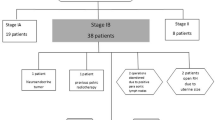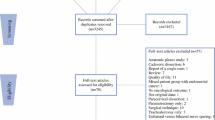Abstract
Background
The purpose of this observational study was to evaluate disease-free survival, overall survival, local recurrence rate, and morbidities in patients submitted to class III nerve-sparing radical hysterectomy (NSRH) compared with standard radical hysterectomy (RH) in cervical cancer (CC). This was a comparative study in the context of multimodal therapies.
Materials and Methods
We investigated patients with CC admitted to the National Cancer Institute of Milan between January 4, 2001, and September 29, 2009, treated with NSRH. We compared patients operated with RH between March 20, 1980, and December 28, 1995. A total of 496 patients were enrolled. The median follow-up was 93 months (42 and 159 months for the NSRH and RH groups, respectively).
Results
The overall number of relapses was 30 out of 185 and 60 out of 311 for NSRH and RH, respectively. Five-year disease-free survival estimate was 78.9% (95% confidence interval [CI] 72.0–85.7) in NSRH and 79.8% (95% CI 75.3–84.3) in RH (P = 0.519). Five-year overall survival estimate was 90.8% (95% CI 85.9–95.6) in NSRH and 84.1% (95% CI 8.0–88.3) in RH (P = 0.192). Rates of postoperative serious complications were 9.7% and 19.6% for NSRH and RH, respectively (P = 0.004). Positive pelvic lymph node and vagina status were significant (P < 0.01) independent predictors by multivariable analyses.
Conclusions
The oncologic results were comparable between NSRH and conventional class III RH in the context of two multimodal treatments. Bladder function and postoperative complications rate are improved by nerve-sparing technique. The nerve-sparing technique should be considered in all CC patients addressed to surgery because it improves functional outcome and preserves radicality without compromising overall survival.

Similar content being viewed by others
References
Meigs JV. Radical hysterectomy with bilateral dissection of pelvic lymph nodes: surgical treatment of cancer of the cervix. New York: Grune & Stratton; 1954.
Kobayashi T. Abdominal radical hysterectomy with pelvic lymphadenectomy for cancer of the cervix. Tokyo: Nanzando; 1961. p. 178–87.
Fujii S. Anatomic identification of nerve-sparing radical hysterectomy: a step-by-step procedure. Gynecol Oncol. 2008;111(2 Suppl):S33–41.
Yabuki Y, Asamoto A, Hoshiba T, et al. Dissection of the cardinal ligament in radical hysterectomy for cervical cancer with emphasis on the lateral ligament. Am J Obstet Gynecol. 1991;164:7–14.
Hockel M, Konerding MA, Heussel CP. Liposuction-assisted nerve-sparing extended radical hysterectomy: oncologic rationale, surgical anatomy, and feasibility study. Am J Obstet Gynecol. 1998;178:971–6.
Possover M, Stober S, Plaul K, et al. Identification and preservation of the motoric innervation of the bladder in radical hysterectomy type III. Gynecol Oncol. 2000;79:154–7.
Trimbos JB, Maas CP, Deruiter MC, et al. A nerve-sparing radical hysterectomy: guidelines and feasibility in Western patients. Int J Gynecol Cancer. 2001;11:180–6.
Raspagliesi F, Ditto A, Fontanelli R, et al. Nerve-sparing radical hysterectomy: a surgical technique for preserving the autonomic hypogastric nerve. Gynecol Oncol. 2004;93:307–14.
Ditto A, Martinelli F, Borreani C, et al. Quality of life and sexual, bladder, and intestinal dysfunctions after class III nerve-sparing and class II radical hysterectomies: a questionnaire-based study. Int J Gynecol Cancer. 2009;19:953–7.
Papp Z, Csapo Z, Hupuczi P, et al. Nerve-sparing radical hysterectomy for stage IA2–IIB cervical cancer: 5-year survival of 501 consecutive cases. Eur J Gynaecol Oncol. 2006;27:553–60.
Van den Tillaart SA, Kenter GG, Peters AA, et al. Nerve-sparing radical hysterectomy: local recurrence rate, feasibility, and safety in cervical cancer patients stage IA to IIA. Int J Gynecol Cancer. 2009;19:39–45.
Skret-Magierło J, Naróg M, Kruczek A, et al. Radical hysterectomy during the transition period from traditional to nerve-sparing technique. Gynecol Oncol. 2010;116:502–5.
Ditto A, Martinelli F, Hanozet F, et al. Class III NSRH: oncological outcome in 170 cervical cancer patients. Gynecol Oncol. 2010;119:192–7.
Pecorelli S. FIGO Committee on Gynecologic Oncology. Revised FIGO staging for carcinoma of the vulva, cervix, and endometrium. Int J Gynaecol Obstet. 2009;105:103–4.
Raspagliesi F, Ditto A, Kusamura S, et al. Nerve-sparing radical hysterectomy: a pilot study. Tumori. 2003;89:497–501.
Raspagliesi F, Ditto A, Hanozet F, et al. Nerve sparing radical hysterectomy for the treatment of cervical cancer: new research on surgical techniques. In: Varaj HT, editor. Trends in cervical cancer research. Hauppauge, NY: Nova Science Publishers; 2007. p. 97–123.
Korn EL, Dorey FJ. Applications of crude incidence curves. Stat Med. 1992;11:813–29.
Gray RJ. A class of k-sample tests for comparing the cumulative incidence of a competing risk. Ann Stat. 1988;16:1141–54.
Schoenfeld D. Partial residuals for the proportional hazards regression model. Biometrika. 1982;69:239–41.
Brucker PS, Yost K, Cashy J, et al. General population and cancer patient norms for the Functional Assessment of Cancer Therapy-General (FACT-G). Eval Health Prof. 2005;28:192–211.
Landoni F, Maneo A, Cormio G, et al. Class II versus class III radical hysterectomy in stage IB–IIA cervical cancer: a prospective randomized study. Gynecol Oncol. 2001;80:3–12.
Girardi F, Lichtenegger W, Tamussino K, et al. The importance of parametrial lymph nodes in the treatment of cervical cancer. Gynecol Oncol. 1989;34:206–11.
Benedetti-Panici P, Maneschi F, Scambia G, et al. Lymphatic spread of cervical cancer: an anatomical and pathological study based on 225 radical hysterectomies with systematic pelvic and aortic lymphadenectomy. Gynecol Oncol. 1996;62:19–24.
Raspagliesi F, Ditto A, Hanozet F, et al. Nerve-sparing radical hysterectomy in cervical cancer evolution of concepts. Gynecol Oncol. 2007;107(1 Suppl 1):S119–21.
Raspagliesi F, Ditto A, Fontanelli R, et al. Type II versus type III nerve-sparing radical hysterectomy: comparison of lower urinary tract dysfunctions. Gynecol Oncol. 2006;102:256–62.
Samlal RA, Van der Velden J, Van Eerden T, et al. Recurrent cervical carcinoma after radical hysterectomy: an analysis of clinical aspects and prognosis. Int J Gynecol Cancer. 1998;8:78–84.
Benedetti-Panici P, Greggi S, Colombo A, et al. Neoadjuvant chemotherapy and radical surgery versus exclusive radiotherapy in locally advanced squamous cell cervical cancer: results from the Italian multicenter randomized study. J Clin Oncol. 2002;20:179–88.
Buda A, Fossati R, Colombo N, et al. Randomized trial of neoadjuvant chemotherapy comparing paclitaxel, ifosfamide, and cisplatin with ifosfamide and cisplatin followed by radical surgery in patients with locally advanced squamous cell cervical carcinoma: the SNAP01 (Studio Neo-Adjuvante Portio) Italian Collaborative Study. J Clin Oncol. 2005;23:4137–45.
Lissoni AA, Colombo N, Pellegrino A, et al. A phase II, randomized trial of neo-adjuvant chemotherapy comparing a three-drug combination of paclitaxel, ifosfamide, and cisplatin (TIP) versus paclitaxel and cisplatin (TP) followed by radical surgery in patients with locally advanced squamous cell cervical carcinoma: the Snap-02 Italian Collaborative Study. Ann Oncol. 2009;20:660–5.
Trimbos JB, Franchi M, Zanaboni F, et al. “State of the art” of radical hysterectomy; current practice in European oncology centres. Eur J Cancer. 2004;40:375–8.
Querleu D, Morrow CP. Classification of radical hysterectomy. Lancet Oncol. 2008;9:297–303.
Acknowledgment
All authors have participated in data collection, data analysis, and the writing of the paper. None of the authors has a conflict of interest. No funds have been received for this work. The study was approved by the institutional ethics committee.
Author information
Authors and Affiliations
Corresponding author
Rights and permissions
About this article
Cite this article
Ditto, A., Martinelli, F., Mattana, F. et al. Class III Nerve-sparing Radical Hysterectomy Versus Standard Class III Radical Hysterectomy: An Observational Study. Ann Surg Oncol 18, 3469–3478 (2011). https://doi.org/10.1245/s10434-011-1767-3
Received:
Published:
Issue Date:
DOI: https://doi.org/10.1245/s10434-011-1767-3




